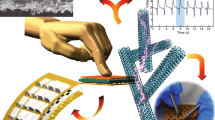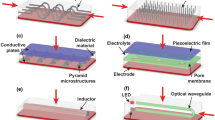Abstract
The purpose of this study is to investigate the directionality of the tactile sensation capability of human fingertip in recognizing fine step-heights of about 10 μm and discuss the mechanism of the directionality. We have developed a measurement system that presents a step-height to a subject fingertip and measures the human tactile sensation capability. The presentation device can control four parameters of the presentation, which are the step-height, the presentation velocity, the presentation angle, and the presentation temperature. In this paper, to investigate the finger’s tactile sense directionality, we conducted two kinds of psychophysical tests. In the tests, the step-heights of about 10 μm with three different presentation angles of 0, 45 and 90 degrees are used as the presentation stimuli. In the first psychophysical test, human subjects touch and distinguish, using the center of their fingertips, each pair of the step-heights that have the same presentation angles, 0 vs. 0, 45 vs. 45 and 90 vs. 90 degrees. In the other test, they distinguish each pair of the step-heights that have the different presentation angles, 0 vs. 0, 0 vs. 45 and 0 vs. 90 degrees. From these psychophysical tests, the difference thresholds and subjective equalities for the step-heights are determined and the relationship between the fine-step’s presentation angle and the fingertip’s tactile sensation is revealed. As a result, it is found that the step’s presentation angle has an influence on the human tactile sensation capability. In addition, the mechanism of the fingertip’s tactile sense directionality is discussed.











Similar content being viewed by others
References
Gescheider GA (1984) Psychophysics: method, theory, and application, 2nd edn. Erlbaum, Hillsdale
Heller MA (1989) Texture perception in sighted and blind observers. Percept Psychophys 45:49–54
Kawamura T, Ohka M, Miyaoka T, Mitsuya Y (1996) Measurement of human tactile sensation capability to discriminate fine surface texture using a variable step-height presentation system. In: Proceedings of the 5th IEEE int workshop on robot and human communication, pp 274–279
Kawamura T, Ohka M, Miyaoka T, Mitsuya Y (1998) Human tactile sensation capability to discriminate moving fine texture. In: Proceedings of the 7th IEEE int workshop on robot and human communication, vol. 2, pp 555–561
Kawamura T, Otobe Y, Tani K (2009) Effect of touching manner and motion direction of human finger on human tactile recognition. In: Proceedings of the 18th IEEE int symp on robot and human interactive communication, pp 998–1003
Kawamura T, Nejigane K, Tani K (2010) Proposal of a hybrid tactile sensor system and its evaluation method for fine deformation. In: Proceedings of the 1st int symp on robotics and intelligent sensors, pp 157–162
Maricich SM, Wellnitz SA, Nelson AM, Lesniak DR, Gerling GJ, Lumpkin EA, Zoghbi HY (2009) Merkel cells are essential for light-touch response. Science 324:1580–1582
Miyaoka T, Mano T (1993) A neural information processing model to illustrate the dependency of vibrotactile adaptation on the simulated site of the human hand. Jpn Psychol Res 35:41–45
Miyaoka T, Ohka M, Kawamura T, Mitsuya Y (1996) Fine surface-texture discrimination ability depends on the number of mechanoreceptors participating in the discrimination task. J Acoust Soc Am 100(4–2):2771. doi:10.1121/1.416398
Miyaoka T, Mano T, Ohka M (1999) Mechanisms of fine-surface-texture discrimination in human tactile sensation. J Acoust Soc Am 105(4):2485–2492
Schmid RF (1986) Fundamentals of sensory physiology. Springer, Berlin
Tanaka N, Kawamura T, Tani K (2009) Directionality of human tactile sensation capability in discriminating fine step-heights. In: Proceedings of the 18th IEEE int symp on robot and human interactive communication, pp 1010–1015
Taylor MM, Creelman CD (1982) PEST: efficient estimate on probability function. J Acoust Soc Am 41(4):836–855
Vallbo ÅB, Johansson RS (1984) Properties of cutaneous mechanoreceptors in the human hand related to touch sensation. Hum Neurobiol 3:3–14
Acknowledgements
The authors acknowledge that this work was partly supported by KAKENHI (Nos. 19700161 and 21700190).
Author information
Authors and Affiliations
Corresponding author
Appendices
Appendix A: Method of Constant Stimuli
In the method of constant stimuli, subjective equalities and difference thresholds are calculated using discrimination characteristic curves. In the psychophysical experiments using the method, stimulus pairs of the standard and comparison stimuli are prepared beforehand. The standard stimuli of δ s and the comparison stimuli of δ c are presented to human subjects in random order. For each δ s , the proportion of the responses that the human subjects choose δ c as stronger than δ s is calculated and the discrimination characteristic curve is obtained. In this paper, to determine the subjective equalities and the difference thresholds, the characteristic curve is linearized using the standard normal distribution function. The function is given as follows:
where Z is the standard score. The proportion of the responses of choosing δ c as stronger than δ s is given as follows:
Z is calculated by the inverse function as follows:
Then, the linear function is obtained as follows:
where A and B are unknown quantities.
Next, the two unknown quantities of A and B are calculated in the method of least squares as follows:


where δ c1,δ c2,…,δ cn are the comparison stimuli, \(\bar{\delta}_{c}\) is the calculated average, Z 1,Z 2,…,Z n are the calculated standard scores, and \(\bar{Z}\) is the calculated average.
The difference thresholds and the subjective equalities are derived from S 0.25,S 0.5 and S 0.75 that are equal to the comparison stimuli of δ c calculated by assigning Z=−0.6745,0 and 0.6745 in (A.4), respectively. Here the value of S 0.5 is the subjective equality. Also the values of Δ U =S 0.75−S 0.5 and Δ L =S 0.5−S 0.25 are the upper and lower thresholds, respectively, and the average of the upper and lower thresholds is the difference threshold of Δ.
Appendix B: Parameter Estimation by Sequential Testing (PEST)
Taylor and Creelman developed the PEST (Parameter Estimation by Sequential Testing) method [13]. This is a method to determine difference thresholds and subjective equalities in psychophysical experiments where the stimulus magnitudes of standard and comparison stimuli are controlled by a computer and the stimuli are presented to human subjects in random order. The comparison stimulus magnitude in each trial block is determined based on the human subject’s successive responses according to the following PEST algorithm consisting of three groups of rules.
Rule 1
(Condition for changing stimulus magnitude)
A PEST sequence consists of several trial blocks composed of several trials. Let us consider the n-th trial block. The comparison stimulus is constant throughout the same block. Let L n ,T n and C n be the stimulus magnitude, the trial number and the number of the human subject’s correct answers at the current block, respectively. For a specified P, the proportion of C n against T n , the fault-answer number E n is given as follows:
where the value of P is 0.25, 0.5, or 0.75 to obtain the lower threshold, the subjective equality, or the upper threshold, respectively. Let E p be the permitted error number. If the condition:
is satisfied, then the experiment continues with the same comparison stimulus. If the condition is not satisfied, then the comparison stimulus is varied and the trial block is incremented to the (n+1)-th trial block. The comparison stimulus is decreased whenever (B.3) is satisfied and increased whenever (B.4) is satisfied. Equations (B.3) and (B.4) are given as follows:


Rule 2
(Incremental stimulus magnitude)
The incremental width of the stimulus magnitude in the n-th trial block, W n , should decrease as the number of trials increase to converge the comparison stimulus. If the current comparison stimulus differs considerably from the convergent value of the comparison stimulus, the incremental width should increase to reach rapidly the convergent value. Taylor and Creelman empirically determined the rules for the adjustment of the incremental width. In their rules, the convergence condition is judged by the variation in fluctuation direction of the stimulus magnitude. The fluctuation direction (increase or decrease) in the n-th trial block is denoted by D n . The incremental width in the (n+1)-th block is specified as follows:
-
(a)
If the direction D n becomes contrary to the direction D n−1 of the (n−1)-th trial block, then the incremental width W n is set half W n−1, the incremental width in the (n−1)-th trial block.
-
(b)
If D n and D n+1 are the same direction, then W n+1 is set the same as W n .
-
(c)
If D n−1,D n and D n+1 are the same direction and W n−2 is twice W n−3, then W n+1 is set the same as W n . However, if D n−1,D n , and D n+1 are the same direction and W n−2 is equal to W n−3, then W n+1 is set twice W n .
-
(d)
If D n−2,D n−1,D n ,D n+1,… continue in the same direction, then W n+1,W n+2,W n+3,… are each twice the previous incremental width.
Rule 3
(Condition of termination)
The incremental width W n becomes small as the comparison stimulus approaches the standard stimulus. The minimum incremental width, W min , is specified by the PEST algorithm. If the condition of termination:
is satisfied, then the processing is terminated. The difference between the next stimulus, L n+1, and the standard stimulus, δ s , is the threshold or the subjective equality.
Experimental results using PEST are exemplified in Fig. 12 to explain the above-mentioned PEST procedure. In the example, P,E p , and W min are assumed to be 0.75, 1.0, and 0.3 μm, respectively. Also, δ s and the initial increment W 1 are presumed to be 10 μm and 3 μm, respectively. While the calculated result of (B.1) satisfies the condition given by (B.2), the human subject repeats the comparison of the standard step-height of 10 μm with the initial comparison step-height of 20 μm. Since after twelve trials the right side of (B.1) yields 0.75×12−10=−1 and the result satisfies the condition given by (B.3), the comparison step-height is reduced to 17 μm according to Rule 2 (incremental stimulus magnitude). As is evident from Fig. 12, the comparison step-height decreases as the trial number increases. Thereafter, the comparison step-height increases when the condition given by (B.4) is satisfied for a trial block with an 11 μm step-height. Therefore the comparison step-height is bounded because the calculated results alternately satisfy the conditions given by (B.3) and (B.4). However, the comparison step-height decreases gradually due to Rule 2. Finally the calculated W n satisfies the condition of (B.5). The terminated comparison step-height is 11.2 μm and its upper threshold is obtained from the experiment as Δ U =1.2 μm.
Rights and permissions
About this article
Cite this article
Kawamura, T., Tanaka, N. & Tani, K. Directionality of Human Tactile Sense of Fingertip in Discriminating Fine Step-heights. Int J of Soc Robotics 4 (Suppl 1), 67–76 (2012). https://doi.org/10.1007/s12369-012-0149-8
Accepted:
Published:
Issue Date:
DOI: https://doi.org/10.1007/s12369-012-0149-8





